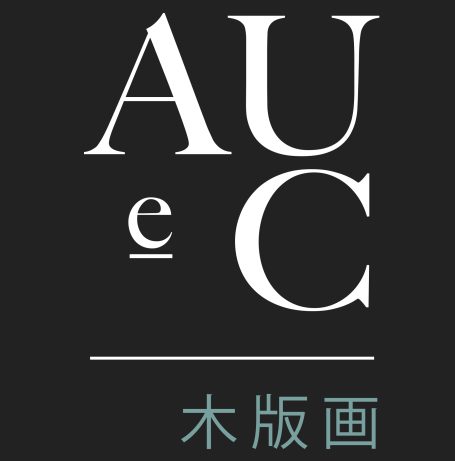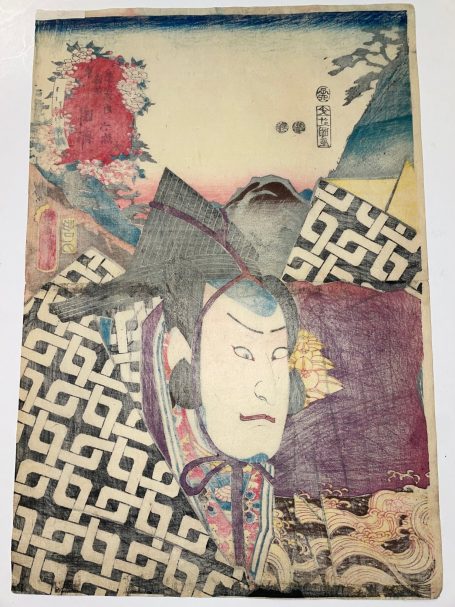Utagawa Kunisada
Tsujiokaya Bunsuke (Kinshodo)
Arashi Kichisaburô III
Publicación: Edo -1852 (Kaei 5)
MEDIUM/TECHNIQUE
Moku hanga 木版画 (Japanese woodcut)
Woodblock printing in Japan (木版画, mokuhanga)
https://en.wikipedia.org/wiki/Woodblock_printing_in_Japan
Nishiki-e (錦絵, "brocade picture")
Japanese multi-coloured woodblock printing;
https://en.wikipedia.org/wiki/Nishiki-e
Tools: Yasutomo Baren
Support: Hosho paper
Dimensions & format:
Ôban; 36 x 25 cm (14 3/16 x 9 13/16 in.)
GRAPHIC WORK

Okabe 岡部
Actor Arashi Kichisaburô III as Rokuyata, from the series Fifty-three Stations of the Tôkaidô Road (Tôkaidô gojûsan tsugi no uchi)
「東海道五十三次ノ内 岡部 六弥太」 三代目嵐吉三郎
Work details
Features: Unic graphics work
ARTIST
Utagawa Kunisada (Japanese: 歌川 国貞; 1786 – 12 January 1865), also known as Utagawa Toyokuni III (三代 歌川 豊国, Sandai Utagawa Toyokuni), was a Japanese ukiyo-e artist. He is considered the most popular, prolific and commercially successful designer of ukiyo-e woodblock prints in 19th-century Japan. In his own time, his reputation far exceeded that of his contemporaries, Hokusai, Hiroshige and Kuniyoshi.
https://en.wikipedia.org/wiki/Utagawa_Kunisada
Artistic genre:
Yakusha-e (役者絵)
https://en.wikipedia.org/wiki/Yakusha-e
Period: 1852 (Kaei 5), September 4º month
Publisher: Tsujiokaya Bunsuke (Kinshôdô) (Japanese)
Blockcutter: Koizumi Minokichi (Hori Mino) (Japanese 1833–1906)
改印:衣笠、村田、子四 彫師:彫巳の
Signed: Toyokuni ga, in toshidama cartouche 豊国画(年玉枠)
Marks: Censor's seals: Kinugasa, Murata, Rat 4
Country of origen: Japón/Edo (Tokyo)
Artist signature:
Toyokuni III 三代歌川豊国
DESCRIPTION AND COMPOSITION ELEMENTS
Okabe 岡部 : Japón city. Distance to Edo: 193 km - Distance to Kyôto: 298.2 km
The Fifty-Three Stations of the Tōkaidō
The Fifty-Three Stations of the Tōkaidō (東海道五十三次, Tōkaidō Gojūsan-tsugi), in the Hōeidō edition (1833–1834), is a series of ukiyo-e woodcut prints created by Utagawa Hiroshige after his first travel along the Tōkaidō in 1832.[1] The Tōkaidō road, linking the shōgun's capital, Edo, to the imperial one, Kyōto, was the main travel and transport artery of old Japan. It is also the most important of the "Five Roads" (Gokaidō)—the five major roads of Japan created or developed during the Edo period to further strengthen the control of the central shogunate administration over the whole country. Even though the Hōeidō edition is by far the best known, The Fifty-Three Stations of the Tōkaidō was such a popular subject that it led Hiroshige to create some 30 different series of woodcut prints on it, all very different one from the other by their size (ōban or chuban), their designs or even their number (some series include just a few prints). The Hōeidō edition of the Tōkaidō is Hiroshige's best known work, and the best sold ever ukiyo-e Japanese prints.[2] Coming just after Hokusai's Thirty-six Views of Mount Fuji series, it established this new major theme of ukiyo-e, the landscape print, or fūkei-ga, with a special focus on "famous views".
https://es.wikipedia.org/wiki/Las_cincuenta_y_tres_estaciones_de_T%C5%8Dkaid%C5%8D
Composition actor:
ARASHI KICHISABURŌ III
playing the roles of Okabe no Rokuyata
https://www.kabuki21.com/kichisaburo3.php
COLLECTION
MFA in Boston has this print. Accession no. 11.45325.
https://collections.mfa.org/objects/498276
Necesitamos su consentimiento para cargar las traducciones
Utilizamos un servicio de terceros para traducir el contenido del sitio web que puede recopilar datos sobre su actividad. Por favor, revise los detalles y acepte el servicio para ver las traducciones.






